The post A Guide to Jasmine Tea – Types, Production and Benefits first appeared on Blog Royal Tips.
]]>Jasmine flowers, with their pretty white petals and wonderful aroma, are popular throughout the world. Their beautiful appearance and calming fragrance mean that they have come to be associated with love and purity. As such, they are often used in religious ceremonies; to add a touch of elegance to bridal bouquets; and in floral arrangements for Mother’s Day. Jasmine flowers are particularly important in Eastern countries, and are amongst the national flowers of the Philippines, Pakistan, and Indonesia.
It is therefore not surprising that this aromatic plant has many practical applications too: it is grown ornamentally in gardens and homes, used extensively in the cosmetics industry to produce exquisite perfumes and bath oils, employed in herbal medicines and, of course, has long been popular as a light and calming flavouring for tea. In the following post, we look into the history of jasmine teas, from their origins to their production processes and health benefits. Read on to discover all you need to know about this wonderful scented tea and why it’s worth taking the time to relax with a cup of jasmine tea.
History
The jasmine plant, a member of the Oleacae family and native to South Asia, is thought to have been introduced to China around the 2nd century BC. Two jasmine species can be used to produce jasmine tea: Common Jasmine, and Sampaguita. Common jasmine is native to the Middle East, while Sampaguita is native to the eastern Himalayas, though both species now grow in many other countries. Common jasmine is the national flower of Pakistan, and Sampaguita the national flower of the Philippines and amongst the national flowers of Indonesia, where it is a symbol of purity and sacredness.
Jasmine has been used to scent tea since the 5th Century AD, but this process really started to become popular during the Ming Dynasty. In this era, which lasted from 1368-1644, the popularity of floral objects and patterns flourished – relics and art from the time commonly incorporate floral motifs – so, naturally, floral-scented teas also began to be consumed more. Jasmine green tea then became even more widespread in the following Qing Dynasty, when it became popular in western markets and its production and exportation rapidly increased. Nowadays, jasmine tea is traditionally produced in Fujian province in China, amongst the vast fields of jasmine plants grown on the mountain sides, although it is also produced in other provinces such as Hunan, Guangdong and Zhejiang.

Types of Tea used for Scenting
Jasmine tea is produced by scenting dry tea leaves with the intense yet delicate aroma of fresh jasmine blossoms. While lower quality teas are produced using natural or artificial essential oils, the highest quality jasmine teas are made by mixing tea leaves with the jasmine flowers, so that they naturally absorb their rich and pleasant fragrance. Tea scented in this way provides a delicate and refreshing taste, without being overly sweet. Different types of tea can be used in this process, as detailed below.
The most common and popular base is green tea, since it combines perfectly with the jasmine scent to produce a subtly sweet flavour and beautiful fragrance.
To obtain a more complex and distinct floral flavour, Oolong tea can be used, although it is less commonly found in western markets. The oxidation levels of these teas can vary considerably, without reaching the levels of black tea, so this type of tea sits between green and black tea in terms of strength.
For those who prefer a very strong taste, black tea can be used as the base: since it is made by oxidising tea leaves to their maximum, its flavour is far stronger. Enriched with the jasmine aroma, black tea can surprise us with its lightness and lack of astringency.
For those who enjoy teas with more subtle flavours, like white Silver Needle tea, jasmine aromas can be their ideal ally. The delicious and fragrant infusion of high quality, white tea harmonises divinely with the delicate aroma of jasmine flowers, making it into an incredible sensory experience for any tea lover.
Most Popular Jasmine Teas
Jasmine Dragon Perl Tea
Jasmine Dragon Pearls are popular for their freshness and charming appearance. The green tea leaves are meticulously rolled into tight little balls, to give them a beautiful neat appearance. Those with plenty of downy white tips and smaller size are the young tender flushes picked in early spring that represent the highest grade jasmine tea.
The natural jasmine scent, transferred from the jasmine flowers to the tea leaves during the production process, pairs well with the sweet flavour of green tea, adding an incredibly delicate, floral dimension to the liquor. The way the pearls unfurl in the water also produces a spectacular, hypnotic treat for the eyes when it comes to brewing the tea.
Loose Leaf Jasmine Green Tea
Just as with Jasmine Pearls, high quality jasmine loose leaf teas are made from spring-picked tea leaves which are then scented with jasmine flowers in the summer. In this case single leaves are used for scenting instead of leaf shoots.
The young tea leaves are packed with antioxidants, so they provide a lot of advantages for those who wish to benefit from the health properties of green tea, with the pleasant taste of jasmine also being gentle on the stomach.
Jasmine Silver Needles (Moli Bai Hao Yin Zhen)
Jasmine Silver Needles are the most popular scented white tea. This superb, elegant tea is made by scenting the hand-picked Silver Needle tea buds with freshly picked jasmine blossoms. The delightful, subtle fragrance of the finest white tea combines perfectly with the delicate aroma of jasmine blossoms, making it an incredible sensory experience for any tea lover.
However, it shouldn´t be forgotten that white teas can contain high levels of theine. The fresher and younger the buds, the higher the concentration of theine there will be in the dry leaves, with Jasmine Silver Needles having the highest level of all white teas since they are made using only buds from the Camellia sinensis plant.
If you are a fan of jasmine, it’s worth trying different types of jasmine tea to discover which best suits your palate: we are sure you’ll find something you love!
The Production of Jasmine Teas
To begin, tea leaves are picked in spring, when the buds are still small and any open leaves are tiny. Just the new shoots, each comprising a bud and two leaves, are used. These fresh leaves are taken to the factory, where they are toasted in order to prevent oxidation, gently rolled into small pearls, each pearl wrapped in tissue paper to hold the shape, and dried. Although they are now ready to be used as tea, they must be stored for a number of months until the ideal moment for the jasmine to be added. Jasmine flowers are harvested in the summer and so the dried tea is stored in a cool, dry place until this time.
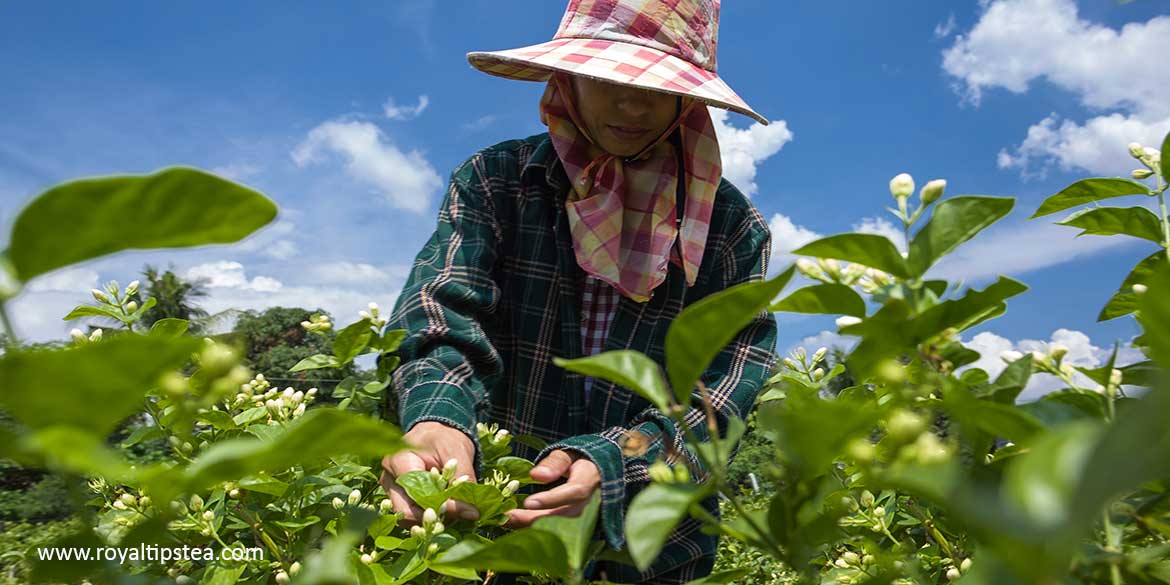
When the jasmine flowers have grown to the ideal point during the summer, they are harvested. They must be picked at the perfect moment: when they are closed during the daytime, and open up at night. If they are picked too early, the buds will not open enough for them to be used to scent the tea. If they are picked too late, when they have already flowered, they will have lost the main aromatic components. When the jasmine plants have reached this opportune stage, they can be used to scent the tea. Branches of jasmine are gathered during the day and brought into the factory and, when they open in the evening, the flowers are removed from the branches.
Then, beginning with a thin layer of jasmine flowers, the jasmine and tea leaves are placed in alternate layers and left to sit for a number of hours while their temperature rises. Once the temperature of these piles has risen to around 45°C, the mixture of tea and flowers is separated into smaller piles in order to allow the tea to cool down. Once they have almost reached room temperature, they are stacked and left again to allow the tea to absorb the fragrance of the blossoms. This process is repeated until the flowers have transferred their beautiful scent to the tea leaves.
Eventually, the blossoms transform into a light yellow colour, indicating they have completely transferred their scent. The mix of tea and flowers are placed into a machine to be sorted, separating the flowers from the tea leaves. The tea leaves are heated at a high temperature, so as to dry them out quickly and to conserve the scent. They are stored until the following night, when the scenting process takes place again with fresh jasmine flowers. This process can be repeated several times until the desired tea quality is reached – for top grade tea, it may even be repeated over eight or nine nights.
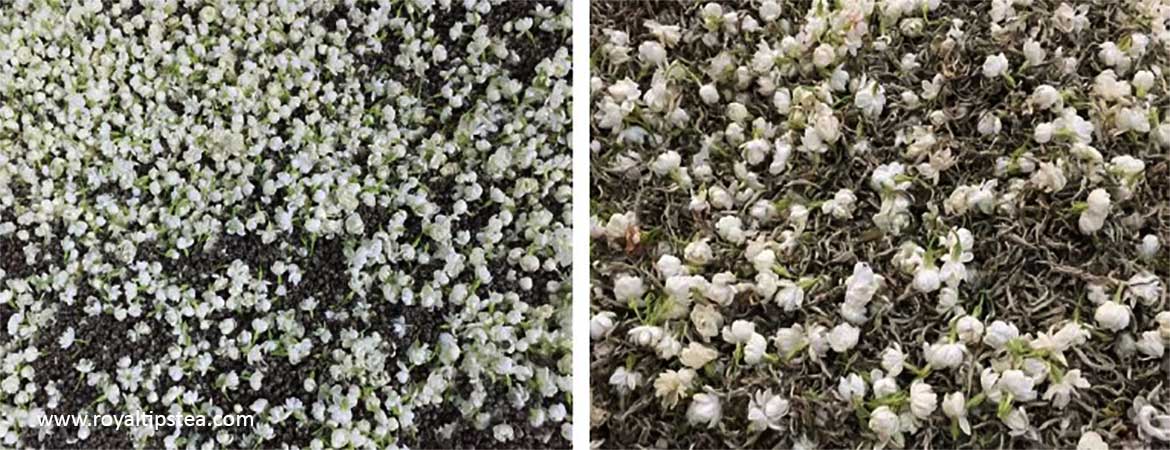
Finally, the tea is dried out again to remove any moisture it has absorbed from the fresh jasmine flowers. Some producers add dried jasmine flowers for a touch of extra decoration before packing the tea for sale.
Health Benefits
Jasmine green tea not only offers a beautiful flavour and scent, but delivers many health benefits too thanks to its high content of antioxidants, including polyphenols and caffeine (theine).
So, how do antioxidants help to maintain our health?
– Firstly, they protect the body from damage from free radicals and environmental toxins, helping to prevent age-related diseases.
– Antioxidants also help to reduce blood pressure and the risk of heart disease, and slow down signs of aging.
– They are naturally anti-inflammatory, which means they’re particularly beneficial for anyone suffering from arthritis: swelling of the joints and arthritic pain may be reduced.
– They boost your metabolism, improving the breakdown of fats. The naturally sweet flavour of jasmine tea also means there is no need to add sugar or sweeteners, further helping you to follow a healthy diet.
– They may also reduce the symptoms of IBD, particularly bloating, since they aid digestion.
– Polyphenols also fight against carcinogens, helping to prevent the development of cancer. They can also prevent the development of, and speed up recovery from, colds and flu, given their antiviral and antibacterial properties.
Finally, studies have shown that jasmine’s beautiful smell in fact acts as a mild sedative, reducing your heart rate. So savouring a cup of jasmine green tea will help you to relax and de-stress, and even help to boost your mood, as well as helping you get to sleep more easily.
The post A Guide to Jasmine Tea – Types, Production and Benefits first appeared on Blog Royal Tips.
]]>The post Top 10 Most Famous Chinese Green Teas first appeared on Blog Royal Tips.
]]>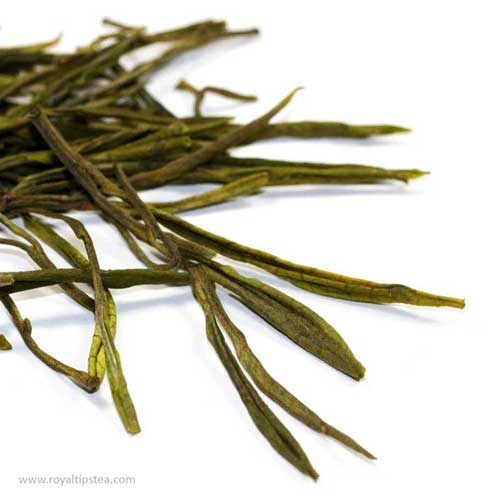
1. Anji Bai Cha (Anji White Tea)
Although the name of this exquisite tea means ‘white tea’, it is in fact a green tea. It is called white because the varietal of the tea plant used to make it produces very little chlorophyll and so the leaves are very pale. As new buds form in the early spring, they look almost white or translucent in the morning sun. The particular varietal was discovered in 1982 in Anji county, Zhejiang province, and to make the tea, young shoots of one bud and one or two leaves are picked right at the beginning of the growing season, then de-enzymed in a hot wok, rolled by hand or in a panning machine, then dried. The long, elegant, pointed dry leaves look like pine needles. The tea contains high levels of amino acids so is sweet and smooth.
2. Longjing (Dragon Well)
Long Jing is also made in the West lake region of Zhejiang province and is processed by hand using a heated wok to carry out the three important processing steps required to make green tea – panning to stop oxidation, pressing to develop flavor, drying to remove all but 2-3% of water in the leaves. Tea makers use their flat hands to move the little bud sets around the pan and, when they have finished, each tea bud is flat and shiny and yellow-green. The brew is sweet and smooth, with hints of young green vegetables such as broccoli, asparagus and pea-pods. The legend of Long Jing says that the Emperor visited the Hu Gong Temple in West Lake one day and was presented with a bowl of the tea. He was so impressed by the delicious taste and aroma that he gave ‘imperial status’ to the 18 tea bushes growing in front of the temple.
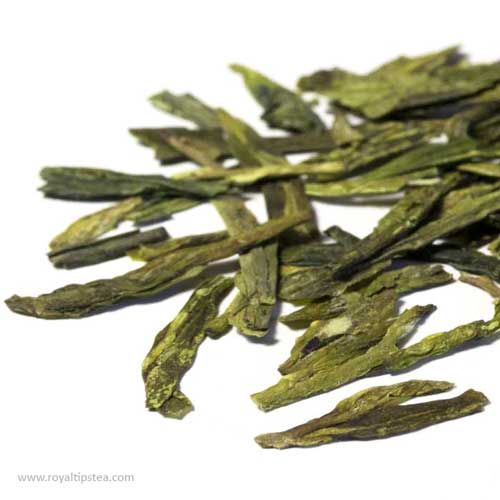
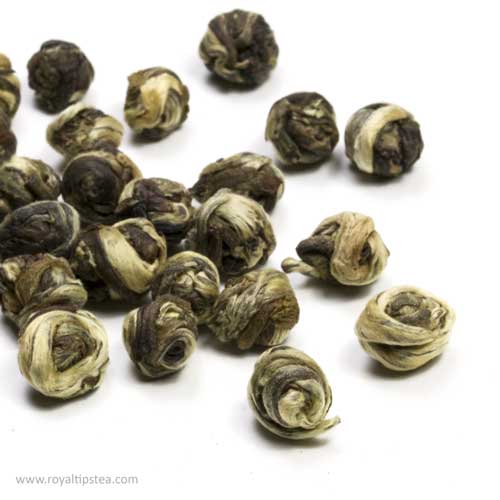
3. Jasmine Pearls
Loose Jasmine teas and Jasmine Pearls are made in Fujian province. To make loose green tea, the freshly picked tea shoots are withered for a couple of hours, then panned to stop oxidation, lightly rolled, and then dried. To make the little pearls, little shoots of one bud and 2 tiny leaves are withered briefly, panned and lightly rolled. Then two or three small shoots are gathered together and rolled by hand into neat little balls. Each pearl is then wrapped in tissue paper to hold the shape while the tea is dried. The best teas are made in the early spring and then are very carefully stored. The jasmine flowers bloom in July and August and sprigs of flowers are cut during the day, taken into the factory and, in the evening when the flowers open, all the blossoms are taken off the branches. The tea is then brought out of storage and the jasmine flowers are layered with the tea. The heaped tea and flowers can become quite hot so, during the night, so the layers of tea and flowers must be spread out to allow them to cool and then they are re-heaped. The best jasmine teas are flavoured 8 or 9 times over 8 or 9 nights, each time with a new batch of fresh jasmine blossoms.
4. Mao Jian (Jade Tips)
Mao Jian comes from Henan province and is a very tippy tea with a lovely sweet taste. The word ‘mao’ refers to the downy covering on the little buds and baby leaves; ‘jian’ refers to the shape of the leaves which are pointed and sharp. It is made in the spring and autumn but the best are those picked in early April, before the rains come, when the growth is still slow. When the weather is cool and there is very little rain, the new buds develop very slowly and so concentrate sweetness and subtle flavor in the new flush. It takes approximately 50,000 little bud shoots to make 50 grams of tea.
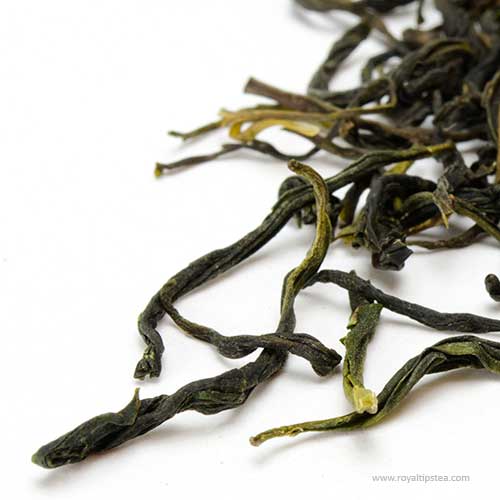
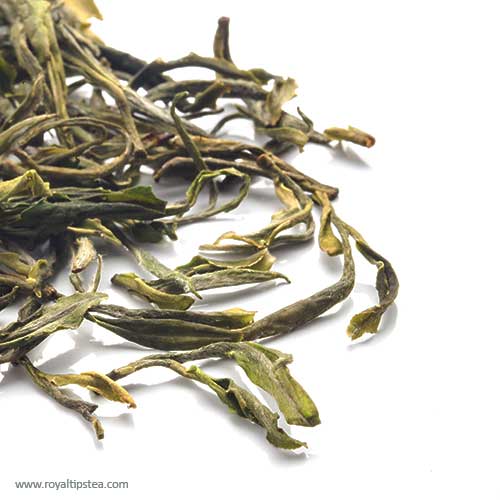
5. Huang Shan Mao Feng (Yellow Mountain Fur Peak)
This famous tea comes from Huang Shan (Yellow Mountain) in Anhui province where Keemun black tea is produced. The same varietal of the tea plant is used to make both black Keemun Mao Feng and green Mao Feng. The word ‘mao’ comes from the little white furry hairs on the outside of the tiny buds, and ‘feng’ means peak, referring to the pointed tip of the bud which looks like the peak of a mountain. The best quality teas are harvested in late March, early April, before the Qing Ming Festival of Pure Light (also called the Tomb Sweeping Festival) which falls on 4th or 5th April each year.
6. Taiping Hou Qui (Taiping Monkey King)
The story behind this rare and famous tea (only recently available in the West), tells how monkeys in the mountain area where the teas are made were very mischievous and used to damage the farmers’ crops. One day a young monkey went missing and the father monkey looked everywhere for his son, but could not find him and collapsed, tired out, in the mountains. Mr Wang Loa’r, one of the local farmers, found the exhausted father monkey and took him to his home to treat him with herbal cures. When he recovered, the father monkey was so grateful that he promised to make sure that in the future his fellow monkeys helped the farmers to pick their tea. So Mr Wang named his tea Taiping Monkey King. The tea is made from a tea varietal with very long bud and leaves and so the dried tea is almost like long green spears. The process involves panning the tea and then pressing the shoots between fine wire mesh stretched across a wooden frame. Some manufacturers use a muslin cloth to protect the leaves and, after drying, the leaves bear the criss-cross pattern of the wire mesh or muslin cloth. The tea needs to be brewed in a tall glass or large teapot because the leaves are so long.
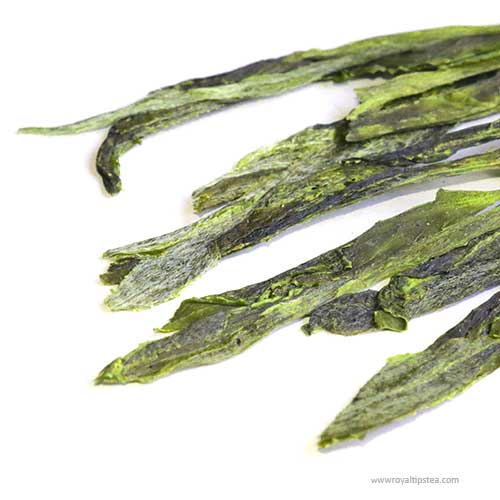
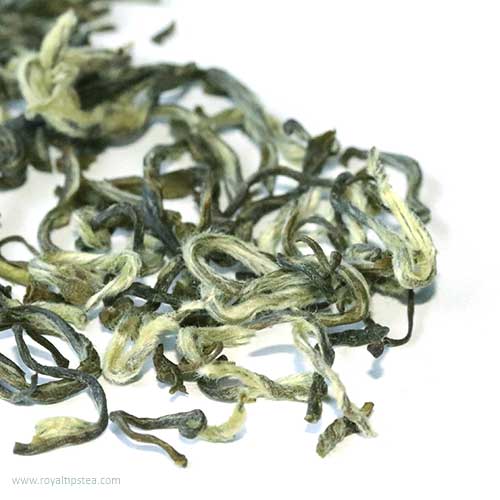
7. Bi Luo Chun (Green Snail Spring)
The tiny spirals of downy buds of this delicate tea are produced in the Dongting mountains of Jiangsu province. It takes between 14,000 and 15,000 baby shoots to make one kilo of Bi Luo Chun green tea and the names comes from the fact that the little curls of spring-picked buds look like tiny snail shells. The best teas are processed by hand and the tea masters who make them pan them in hot woks, then as the tea gently dries, they shape the leaves into small twisted curls by rolling them carefully between the palms of their hands. The silver-green leaves have a floral aroma and brew a liquor that is slightly nutty, fruity, sweet and smooth.
8. Liu An Gua Pian (Little Melon Seed)
Made in Anhui province, this tea has a long history dating back to the 8th century AD. During the Qing Dynasty (1644 to 1912) it was a tribute tea presented to the Emperor and his family. The name has become confused over time. At first called ‘sunflower seed slice’ because of the shape of the curled green leaves, the name was shortened to Guan Pian which means ‘water melon slice’. The pluckers harvest only mature open leaves approximately 4cm long, with no stems or buds. The leaves are then withered for a couple of hours, then panned and dried in wok, and as they dry they are stirred round and round with bamboo brushes which give the leaves a slightly curled shape. The tea is given a final drying in bamboo baskets that are placed repeatedly for just a few seconds each time over smouldering charcoal. The taste is quite strong, sweet and very round in the mouth, with a little astringency. The charcoal roasting gives the tea a unique depth and complexity unusual in green teas.
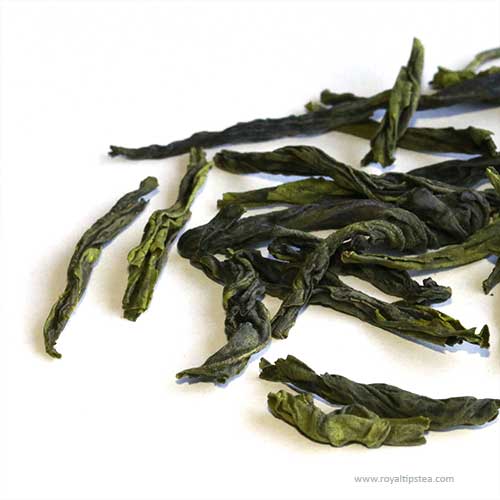
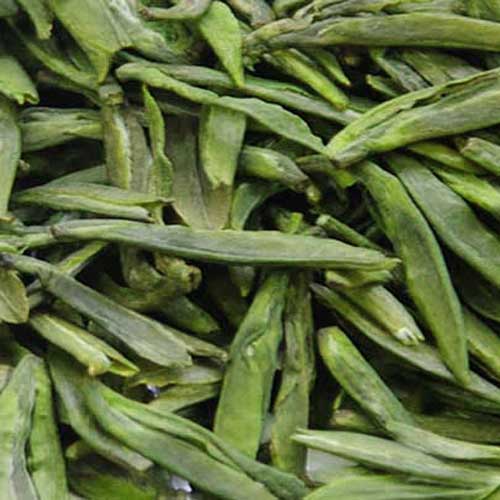
9. Zhu Ye Qing (Bamboo Green Tea)
This rare green tea is grown at altitudes of around 3000 metres on misty Emei Shan (Emei Mountain) in Sichuan province and is said to have first been made at a temple there. When a Chinese army general visited the temple in 1964, he was asked to give the tea a name and he chose the name Green Bamboo because he thought the little buds and leaves had the appearance of young bamboo leaves. The little glossy buds really look just like tiny pea pods. Plucking starts in late March and goes on until the end of April and the pickers gather little shoots of one tiny bud with a small leaf attached. The tea liquor is greeny-gold and the flavour is clean, elegant, lightly astringent and with hints of bamboo shoots, young asparagus and chestnuts.
10. Tian Mu Yun Wu (Clouds and Mist from Tian Mu Mountain)
The deep green, curly leaves of Tian Mu Yun Wu are produced in Tian Mu Mountain in Zhejiang province. Little shoots of one bud and one leaf are harvested in early April and it takes about 62,000 baby shoots to make one kilo of tea. The clouds and mist that swirl around the mountain all the time cut out a lot of the sunlight and this means that fewer of the sweet amino acids in the tea leaves are converted to bitter polyphenols, so the tea is always sweet, mild and smooth, with a pleasant lingering aftertaste. Brew the little buds in a tall glass to see them slowly absorb water and then drift elegantly down to the bottom of the glass, their pointed tips uppermost, and then rest there, waving like tiny sea anemones.
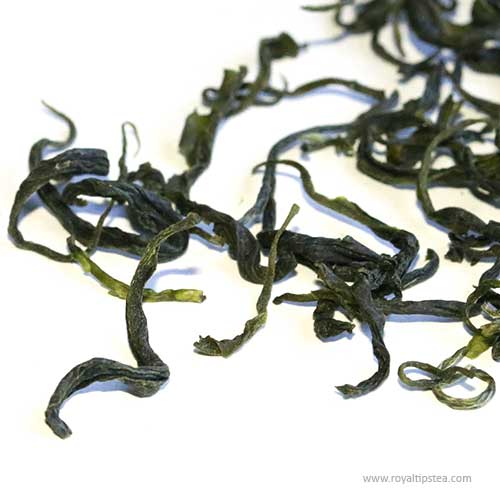
The post Top 10 Most Famous Chinese Green Teas first appeared on Blog Royal Tips.
]]>The post The story of Oriental Beauty oolong tea first appeared on Blog Royal Tips.
]]>What does Oriental Beauty oolong tea owe its popularity to?
Known for its fruity fragrance and bittersweet flavour with a touch of Muscat grape, this magnificent oolong tea is produced in a somewhat different manner to other oolongs. Firstly, the tea is left to wither for a longer period than is usual for oolongs due to the high level of humidity in the region where this tea is cultivated. The oxidation level of Oriental Beauty is higher than most other oolongs (about 70%), and the little shoots are then panned and rolled very carefully so as not to break them. All of these factors give this tea a unique aromatic dimension.
Aromatic compounds as a defence mechanism in Oriental Beauty tea leaves
Apart from the unusual manufacturing process, what really makes Oriental Beauty so popular is the fact that the young leaves of this fascinating oolong tea are invaded by tiny insects while they are growing. When they know they are being “attacked”, the plants activate their defence mechanisms, generating aromatic compounds that are designed to deter the insects from biting. These aroma compounds are enhanced during the manufacture of the tea. The damage caused by the insects also causes a light oxidation in the leaves while they are still growing on the plant. The same effect is achieved during the bruising or shaking stages of oolong processing , when the cells of the leaves are slightly broken in order to induce light oxidation, while at the same time preserving the leaves intact.
For the production of oolong teas, tea manufacturers usually select mature tea leaves (up to 3 or 4 tea leaf) without buds. Instead, Oriental Beauty oolong tea is manufactured using the unopened buds and the first two young leaves of the plant, as they are the most attractive to insects. The invasion usually occurs during the summer months and causes the price of tea harvested in this period to shoot up.
Defence mechanisms in plants are more complex than may appear at first glance. When a plant feels threatened, it will adopt a specific defence response depending on the nature of the attack. This means that not all insects will cause the same molecular changes in the plant as a response to attack and potential damage. In the case of Oriental Beauty the insect responsible for the production of volatile aromatic compounds in the tea leaves is called Empoasca Onukii (Cicadellidae family), or Jacobiasca formosana, commonly known as leafhoppers. To make the highest quality Oriental Beauty, the producer selects only the leaves that are attacked by the insect, which increases the fragrance of the oolong tea. This work requires a great deal of knowledge, as the amount of leaf damage also influences the flavour of the tea. Even so, the infestation does not occur in all tea plantations and producers tend to manage their gardens in the most natural way possible in order to attract the tiny creatures.
The role of terpenes in the development of taste in Oriental Beauty oolong
Terpenes are volatile components that are responsible for the fragrance of oolong and black teas, and play an essential role in the formation of the complex aromatic range of flavours found in Oriental Beauty oolong tea. Among the most important are linalool and its derivatives, geranium, benzyl alcohol and phenethyl alcohol. Linalool and geranium terpenes contribute to the aroma of Muscat both in oriental beauty and in the best Darjeeling teas. The insect’s bites cause a light oxidation of the tea leaves while they are still growing on the plant, inducing the formation of other terpene components, such as diol (adds a honey and citrus taste) and hotrienol (also present in wines along with linalool and geranium and whose effect increases the muscat aroma). Terpenes usually interact in such a way that one can intensify the aroma of the other, so the leaves of Oriental Beauty that have been invaded by insects will possess an even more intense and more complex flavour. However, this can be a difficult tea to find and it is usually rather expensive. The biggest dilemma is that the appearance of the tea leaf alone is not enough to determine whether or not it was infested by the insects. What matters truly is that Oriental Beauty is a very special tea in itself, because its manufacturing process gives it a distinctive flavour that many sellers attribute to the insects in order to create a greater interest in this wonderful tea.
Oriental Beauty, an oolong tea with many names and a long history
The Chinese name for this oolong tea is Dong fan Mei Ren (東方美人) and is translated as “Oriental Beauty”. It is also commonly called Formosa Oolong, Eastern Beauty Oolong, Champagne Oolong, Bai Hao Oolong (white tips Oolong), Bragger’s Oolong, etc. Bai Hao Oolong is translated as “white-tipped Oolong tea” due to the high number of white buds that are used in the production of this tea.
Several stories are told about the origin of Oriental Beauty. One of them states that, in the past, tea leaves that were damaged by insects were considered defective and therefore discarded. One day, a producer decided to process the damaged leaves in an effort to take advantage of the harvest. The taste of the tea that was obtained from these leaves was so spectacular that the producer was able to sell it at a very high price. He boasted about the high price to his neighbours and so the tea was named “Bragger’s Tea” (Pengfeng tea). What is certain is that during the time when the island of Taiwan was under Japanese jurisdiction, the Government of Japan actively promoted the tea industry, emphasizing the quality of production and expansion strategies in the tea market. China in turn boosted the propagation of tea culture when the island passed back to its control after the Second World War. The fusion of different cultures was an enriching experience for tea producers in Taiwan and contributed to the success and fame of the spectacular Taiwanese teas as we know them today.
The post The story of Oriental Beauty oolong tea first appeared on Blog Royal Tips.
]]>